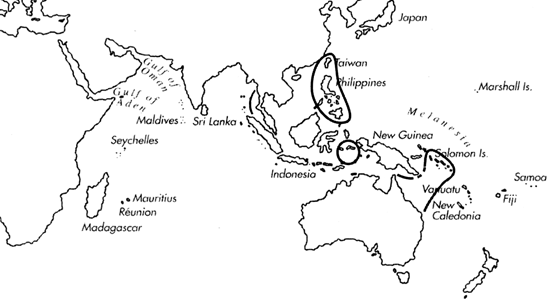Range: Taiwan, Philippines, Java, Solomon Is., Queensland, and W. Thailand; probably Moluccas.
Description: Medium-sized to large, moderately solid to solid. Last whorl ventricosely conical; outline convex at adapical third, less so or straight below. Shoulder angulate to subangulate. Spire usually of moderate height, outline concave to nearly straight. Larval shell of 3 or more whorls, maximum diameter about 0.8 mm. First 2-4 postnuclear whorls tuberculate. Teleoconch sutural ramps flat to slightly concave, with 0-1 increasing to 7, sometimes to 11 spiral grooves that contain spiral threads in latest whorls. Last whorl usually almost smooth; in subadult and some adult shells, rather widely spaced weak spiral grooves below or to shoulder, with variably broad ribbons between.
| Shell Morphometry | ||
|---|---|---|
| L | 50-89 mm | |
| RW | 0.15-0.70 g/mm | |
| RD | 0.50-0.58 | |
| PMD | 0.75-0.86 | |
| RSH | 0.11-0.18 | |
Ground colour white to pale grey or beige, sometimes with pale bluish violet axial streaks. Last whorl with spiral rows of yellowish to reddish or dark brown dots, bars, and flecks, generally fusing into 2-3 interrupted or almost solid spiral bands, on each side of centre and sometimes below shoulder. Some shells have spiral rows replaced by distinct to obsolete, narrow light brown bands, also concentrated into 2-3 broader bands. Larval whorls white to brown. In shells with usual last whorl pattern, postnuclear sutural ramps with brown to reddish or dark brown radial markings. Aperture white, violet to orange, paler deep within.
Periostracum grey, very thin, translucent, smooth.
Habitat and Habits: In 20-50 m.
Discussion: C. lynceus is very similar to C. pretiosus; for comparison, see the Discussion of the latter species. Some variants of C. inscriptus also closely resemble C. lynceus; they differ in a more prominent spiral sculpture of the last whorl and a brown instead of grey periostracum. In W. Thailand where both species occur sympatrically, C. inscriptus is smaller (L 40-56 mm), tends to have a somewhat less ventricose and broader last whorl (PMD 0.79-0.86; RD 0.55-0.64), and its aperture is white to beige rather than violet.

C. lynceus range map
This section contains verbatim reproductions of the accounts of 316 species of Conus from the Indo-Pacific region, from Manual of the Living Conidae, by Röckel, Korn and Kohn (1995). They are reproduced with the kind permission of the present publisher, Conchbooks.
All plates and figures referred to in the text are also in Röckel, Korn & Kohn, 1995. Manual of the Living Conidae Vol. 1: Indo-Pacific Region.
The range maps have been modified so that each species account has it own map, rather than one map that showed the ranges of several species in the original work. This was necessary because each species account is on a separate page on the website and not confined to the order of accounts in the book.